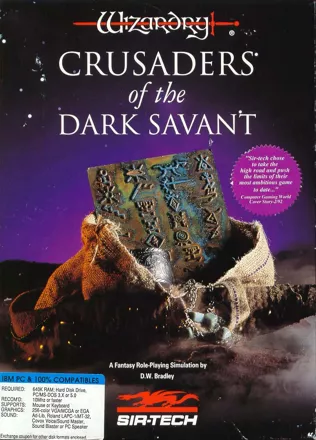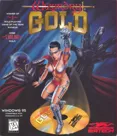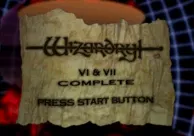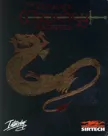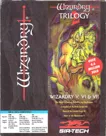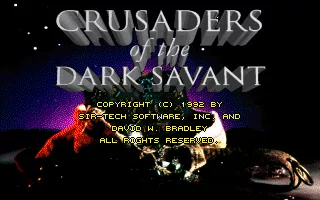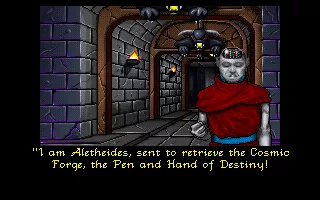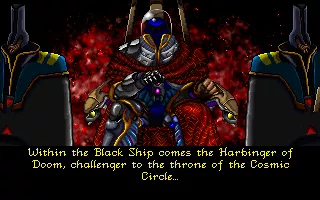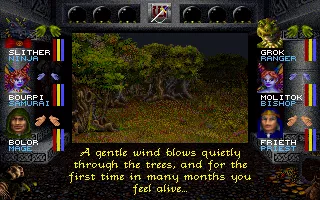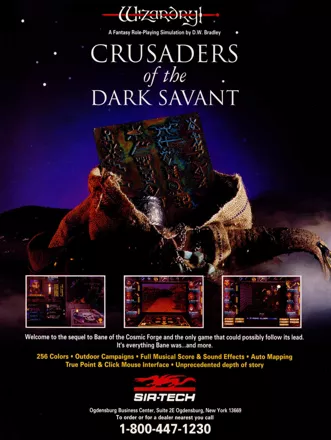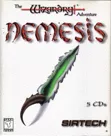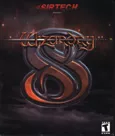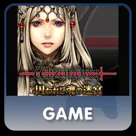Wizardry: Crusaders of the Dark Savant
Description official description
Crusaders of the Dark Savant is the seventh installment of the Wizardry series and a direct sequel to Bane of the Cosmic Forge. In the end of the previous game, the party of heroes finally acquired the Cosmic Forge. However, before they were able to decide what to do with it, it was taken away by a servant of the Cosmic Lords, the cyborg Aletheides. It appears that the Cosmic Forge was in fact a clue to the location of the Astral Dominae, the artifact of life, somewhere on the planet Guardia, which has now been revealed to the universe.
The heroes then travel to Guardia, which is populated by many races and organizations with their own agendas, including the rhinoceros-like Imperial Umpani Federation and the spidery T'Rang affiliated with a malevolent being known as the Dark Savant, whose goal is to get rid of the Cosmic Lords. All these factions are looking for the Astral Dominae, finding which is the primary goal of the game. Depending on the decisions made by the player in the previous game (should he opt to import the party from there), the game will have different openings and begin in different locations. However, regardless of the initial premise, the player is free to follow or betray whatever faction he was supposed to be allied with.
The gameplay system is very similar to that of its predecessor, retaining the races, the classes, the skills and the magic system it introduced to the series. The trademark first-person exploration and turn-based combat are present as well. Unlike the previous games, Crusaders of the Dark Savant allows the player to explore towns and vast forest areas between them, in addition to several large dungeons situated in different areas of the game world. Many NPCs have their own agendas and may move between locations as well, and even obtain crucial items themselves if the player-controlled party is not quick enough, forcing the player to change plans. The exotic setting contains elements of science fiction on top of the traditional fantasy background. Like in the previous game, encounters, events, as well as the heroes' reflections upon them are described through text messages.
A few skills have been added, including swimming and climbing, as well as diplomacy. The latter reflects the more important role dialogues and interaction with NPCs play in the game compared to the previous installments of the series. A mapping skill has been added, which, if learned, displays - for the first time in the computer releases of Wizardry games - an automap on top of the exploration screen. Skills are increased with repeated usage and the characters now receive separate bonus points for each category (weapon, physical, and academia). Like before, magic is divided into four schools (Psionics, Alchemy, Theology, and Thaumaturgy) and six elemental categories.
Spellings
- ウィザードリィⅦ ガーディアの宝珠 - Japanese spelling
- 巫術7:失落的迦地亞 - Chinese spelling (traditional)
Groups +
- Console Generation Exclusives: PlayStation
- Fantasy creatures: Dwarves
- Fantasy creatures: Elves
- Fantasy creatures: Gnomes
- Fantasy creatures: Halflings / Hobbits
- Gameplay feature: Auto-mapping
- Gameplay feature: Character development - Repetition
- Gameplay feature: Character development - Skill distribution
- Gameplay feature: Importable characters
- Physical Bonus Content: Poster
- Protagonist: Female (option)
- Wizardry games
Screenshots
Promos
Credits (DOS version)
55 People (49 developers, 6 thanks) · View all
| By | |
| Written and Programmed By | |
| IBM, Amiga & Macintosh Technical Programming | |
| Graphics Maestro | |
| Graphic Artists | |
| Music Score & Sound Effects | |
| Manual & Documentation | |
| Storyboard Video Sequences | |
| Titlepage Video Sequence | |
| Sound Programming | |
| Manual Illustrations | |
| Map of Lost Guardia | |
| Way above all sense of duty (CMOH) | |
| Macintosh Consultant | |
| Armor Research | |
| Internal Documentation | |
| Playtesters | |
| [ full credits ] | |
Reviews
Critics
Average score: 84% (based on 7 ratings)
Players
Average score: 4.1 out of 5 (based on 44 ratings with 4 reviews)
Like Wagner, great moments punctuating terrible half-hours.
The Good
The coolest thing about the game is that you've got competition. Unlike other games, which say you've got to avoid the enemy or foil the bad guys, CODS/WizGold really means it. Like other cRPGs, you're on an epic quest to defeat the Dark Savant. You're off to save the girl and the magic ...well, you get the idea.
But, there's other folks out there trying to get the girl and the magic...Everyone's following the same clues and if you're resting too much after battles, you'll come to the special treasure chest...and find footprints in the dust letting you know you're a tad late.
Not to worry, you can track down your competitors, and in the tradition of the American Way, beat 'em or join 'em. (Generally speaking, they'll make an offer you'll want to refuse.)
Another cool thing about the game is that there are plenty of bosses ...and they're really challenging to defeat. But, you can find ways 'round 'em (or avoid battling 'em). To make it worthwhile, they'll drop a worthwhile pile of XP and GP and some special items not found anywhere else.
The puzzles, and there are plenty, are plenty challenging. Not for the faint of heart. It'll take a combination of skill, persistence, creativity, and the temptation of online walkthroughs to get to all the areas in the game, including locations of some crucial quest items. Many will get frustrated and give up. Don't. There's at least one way past every obstacle and usually 3-4, which makes the game even cooler.
Finally, the cast of characters, team members, races, classes and locations is imaginative, diverse, and just plain fun. It's cool beyond cool.
Brief note: CODS and Wizardry Gold are the same game, but for the interface. WizGold was SirTech's attempt to come into the modern age of computers (voice-acting, monster pixies, more than a few colors). CODS was the original; you'll almost certainly want to play the WizGold version on a modern PC rather than CODS.
However, note that CoDS has some distinct advantages over its prettier step-sister. Given that the voice acting in WizGold would make Keanu Reaves proud, you'll probably turn the sound off (it slows down the game). WizGold also has a sometimes tedious interface, intolerable in a windows game, but par-for-the-course in DOS.
The Bad
Sigh. All that said, this could have been the best cRPG ever, but... Sigh.
The manual doesn't explain 5% of what you'll want to know before you start nor 5% of what you need to know to adventure...and yet it's one of the most extensive and comprehensive game manuals ever. So, you're more tempted than not to check out hint and guide books or websites...which spoils too much of the fun of the game.
If you get past the interface and the manual, you'll find that, like a lot of the classic AD&D computer games, you spend a lot of time wandering the wide outdoors...only to find there's not much going on. (Dungeons are much more interesting.) It's all too easy to get lost and miss the 2-3 interesting places you want to visit.
On the way to the interesting places, you'll encounter monsters randomly and in set locations (e.g. right in the one place you need to pass through). And unfortunately, there's an unreasonable randomness in the difficulty of your encounters: the XP you gain can vary by a factor of 10,000! (some particular places) and usually by a factor of around 100 -- which either means you're dying without a chance or bored while filleting small rats. Treasure from such battles is also randomized.
Worse, level ups result in random benefits. You're almost required to save/restore in order to have a fighting chance first time through...because level ups come far and few between after about L10.
The Bottom Line
Still, if you get through the boring outdoors and the random battles/levelling...and can figure out the puzzles, it's one of the most fun cRPGs out there.
If you're a Wiz fan, you might like this game more than Wiz8...despite Wiz8's much more comfortable interface and modern graphics.
If you're a Might and Magic IV-V, you'll find the same kind of tongue-in-cheek and serious fun of Terra.
Silver and Gold Box AD&D Fans should love it. In my opinion, CODS has a much more interesting story and adventure and the dislikable things are about the same.
If you can't stand grid based games that require you to do your own mapping, stay away from CODS. Similarly, folks who don't have a lot of time to spare should avoid the seventh Wiz game.
DOS · by Tennessee Ernie Ford (16) · 2003
Role-playing crusade for savants
The Good
It took me a while to get into Wizardry. I've always found Might and Magic games more varied and more dynamic, with their larger and much more open worlds, their flexibility and user-friendliness. The first Wizardry I actually tried to tackle seriously was Bane of the Cosmic Forge. I was fascinated by its character-building aspect, but disappointed by the extreme monotony of its world and its linear progression. I also couldn't quite stomach the lack of an automap feature in a game known for its devilishly complex dungeons. I was therefore somewhat reluctant to play Wizardry 7. To my pleasant surprise, this game fixed everything that was, in my opinion, wrong with its predecessor, while retaining everything that made it great. It is a more generously designed game with a large world open for exploration, a less rigid progression, and new interesting features that come on top of an already excellent role-playing system.
The character creation can give you an idea of the game's depth and potential. I spent almost an hour rolling characters, trying to get that perfect combination of class, race, and attributes, in order to create the party I really wanted. Without knowing the game inside out, however, it is rather impossible on the first try; that is why, somewhere in the middle of the game, I realized that I could have done some things differently and create a more powerful team. The discovery was a joyous one, because my party was perfectly capable of efficiently dispatching the foes, yet out of sheer curiosity and desire for experimentation I'd wanted to replay it before I finished it the first time. The game encourages trying out different combination of classes and skills with your characters, increasing the replay value. And I barely even touched the excellent class-switching system, which allows you to create your own hybrids. Want to have a ninja who can hide in shadows, treacherously backstab and critically hit enemies, and at the same time have at his disposal the entire spell arsenal of an experienced mage? With enough patience, persistence, and planning, you can do that.
Like its predecessor, Wizardry 7 is a beautifully challenging game - and, like it, the biggest challenge is simply exploring it. The entire game is built like an absolutely enormous, highly complex maze. There are two reasons why I enjoyed exploring it more than the comparable environment of Bane: non-linearity and automap. Unlike the previous game, Wizardry 7 doesn't put its areas in a specific order. Of course, some of the game's toughest and most coveted places are blocked off in the beginning due to lack of certain skills and crucial items. Yet it is possible (especially during replays, when you already know where is what) to procure those items fairly quickly, gaining access to areas "out of order". In fact, you can march into the reasonably high-level Giants Cave almost right away - all you need is a high swimming skill, which you gain simply by swimming a lot. But even when you play the game for the first time, you are free to go to four or five large settlements and explore most of its dungeons in any order. This means that you feel much less "stuck" when you face a difficult puzzle - you can always go back and explore some other area, find a friendly person to trade with or get some information, hunt for better weapons or enemies that give more experience, and so on. The game keeps you occupied and interested regardless of what exactly you're doing.
The freedom of gameplay manifests itself also in the way the game handles encounters with its rather eccentric and well-written characters. You can choose to attack and kill anyone you meet in the game. This includes shop owners and crucial quest-givers. As long as you write down exactly what each character tells you, you can always finish the game, even if you literally kill everyone you meet. By the way, these characters are rather talkative, and will provide quite a bit of information, enriching the game's lore - all given to you through old-fashioned, yet strangely fulfilling text parser. They also tend to be memorable and funny. One of my favorites is the poetry-waxing Gorn king with his pseudo-philosophical musings. And who can forget the constantly inebriated brother T'Shober?..
A really interesting feature of the game is NPC movement. Certain characters in the game don't just stand in one place, but wander around, searching for the exact same maps that you are searching for. These maps contain crucial information, and without them it is impossible to finish the game (unless you're replaying it or consulting a walkthrough all the time). The thing is, these NPCs will sometimes get to those maps sooner than you. It will then become your priority to get the maps from them. This can be frustrating, but there are no dead ends in the game, and at any rate it ensures that no playthrough is alike. Another notable feature are role-playing choices. You are free to join either the T'Rang or Umpani in their pursuit of the mysterious lost spaceship. Siding with one of those races will invariably incur the ire of the other, and one of the endings leads to a union with a certain faction. The different endings aren't easy to achieve and figure it - which, again, increases the replay value of the game.
The Bad
Wizardry 7 is tough. The battles, in fact, become more forgiving as the game advances, even if your character development is less than optimal - even simple straightforward leveling up gives you quite an edge. The game's difficulty lies in its puzzles, the clues to which are scattered all over the world and are really hard to find. Essentially, you'll have to explore each one of the game's large and complex dungeons in order to get the maps that give you crucial hints. However, some of those maps will likely have been snatched by your in-game adversaries, which means that you'll also have to find out who exactly has the map, track that person down, and either kill or bargain with him. Naturally, some people (me! me!) with little free time and even less patience can always use a walkthrough, bypassing much of the game's most cryptic and long-winded puzzle quests. Two maps, however, need to be found and used in order to complete the game.
Other difficulties and annoyances mostly lie in the game's somewhat user-unfriendly interface and archaic, hardcore gameplay elements such as the lack of teleportation spells. Luckily, some dungeons do provide reasonable shortcuts for quick post-exploration back-and-forth trekking, and enemy encounters lessen considerably when you backtrack on the same route.
Even though Wizardry 7 is a definite visual improvement over the previous game, it's still not very pretty, and quite monotonous. There is only one kind of tile for the cities, one for the wilderness (which consists entirely out of forest), and two for the dungeons (castle and cave). More importantly, the wilderness feels somewhat too maze-like and too empty. Of course, you can always count on a treasure chest with a great weapon being hidden somewhere in the midst of a thicket, and I suppose that's the reward for plowing through dozens and dozens of identical greenish squares, fighting sprite-sharing enemies on the way. Still, a little more variety would certainly make the game more appealing.
The Bottom Line
Wizardry 7 is, for me, the first truly epic game in the series, one that broke boundaries and expanded beyond its scope, establishing itself as an essential classic RPG. It has everything that made its predecessors great, yet it takes risks and paves a path towards the future. With patience and persistence, this monster of a game can be tamed, and the reward far outweighs the frustration.
DOS · by Unicorn Lynx (181746) · 2018
The Good
This game drops you into a world and from there you are on your own, except for those annoying non-player characters who show up in dungeons to trade or bicker with you. That is what made this game so great. There are other persons walking around Lost Guardia pursuing their own agendas. The bad and not so bad guys are not just sitting around waiting for you to make an appearance. This gives the game an urgency that other computer role playing games lack. The non-player character interaction is heightened by the existing rivalries on the planet. You have five indigineous races and three space faring ones who have set up shop on this little world and they are all out for each other's throats. Talk to a member of one group and see another get angry with you. Its really up to you who to talk to, who not to talk to, who to support and so on.
Did I mention that you are playing a group of humans or elves, or dwarves, or faeires or lizardmen etc (One race is called the Mook who look a lot like Sasquatch) and that you are the only such kind in this world. This is truly an interesting fantasy/science fiction crossover - my elven valkyrie now uses firearms - courtesy service in the Umpani military. All your characters can rise high in stats, which include not only basic statistics - such as strength, dexterity and so forth, but also skills. You can also learn new skills, such as my elven valkyrie, courtesy the planet's inhabitants.
Combat is turn based and the system has you input your orders to your party and then resolves the battle. Combats can last a long time (a certain dinosaur named SPOT comes to mind) and characters can lose both mental and physical stamina from all their fighting. The game demands good party management and as your characters develop they gain many ways to hurt and kill others.
The monsters, not to mention the new races, are a diverse lot. Still the system uses the same picture for all monsters of that type. For example, a black bird could be a raven, a vampire rook, a spectral raven, a fire crow and so forth. This seems primitive in the graphics, but it adds to the fog of war and makes combat more risky. Sometimes you can identify your opponent for what it is and sometimes you cannot.
Trap disarming is a real joy in this game, but I am a fan of games which can challenge both your brain and your hand/eye coordination. Trap Disarming requires, like combat, identifying the nature of the trap and then attempting to disable the mechanisms, in the right order. Picking locks works the same way. You watch the tumblers roll and try to click when it turns green. Hit at the wrong time and you can jam the lock. Hit the wrong color on trap disarming and that could be bye bye to some of your characters.
<br><br>**The Bad**<br> Be prepared to spend quite a lot of time with this monster. Without the aid of a cheat manual, repeated play or the advice of someone else who has plowed through this I do not know who anyone can hope to complete this game in a timely fashion. Some fights are nearly impossible or at least demand constant reloading as you try again and again - in vain it seems - to press on. Just to confess my own dishonor in this department - I reloaded the game myself ten times on my first play in the first fight with a bunch of Rattkin who ambushed me. It took me that many times to get through. This is the only game I know with a Save/Resume function and thank heaven for it. Its the best weapon your party has.
Battles are a problem, but at least they are obvious. Solutions to key quests often are not and be prepared to search and roam and travel in what seems circles till you find out what you have to do and where you have to go. There is even one puzzle, in Munkarama, which changes with every game. There is no one solution. This can be interesting and challenging, but its rarely great fun.
Did I mention, by the way, that your mission is to find an artifact, that was used in the world's creation, before the Dark Savant himself nabs it? Talk about pressure.
<br><br>**The Bottom Line**<br> This is an excellent game in many respects and can appeal to many diverse gaming types - whether you like hack/slash, puzzle solving, or non-player character interaction. This has all three. Still It takes a large investment in time and patience. I confess to never having completed it, but my current party may just get there. Remember that save/resume function!
DOS · by Apparatchik (16) · 2004
Trivia
Starting locations
Wizardry: Crusaders of the Dark Savant features four different starting locations. One for a newly created party, and three additional ones for imported characters fromWizardry: Bane of the Cosmic Forge, depending on how that game was finished (there were three possible endings).
Awards
- Computer Gaming World
- October 1993 (Issue #111) – Role-Playing Game of the Year
- November 1996 (15th anniversary issue) – #105 in the “150 Best Games of All Time” list
- Strategy Plus Magazine
- 1992 – Role-Playing Game of the Year
- PC Games (US)
- December 1992 - PC Games Editor's Choice Award
- 1992 Fantasy Role Playing Game of the Year
- CompuServe Informational Services
- 1992 – Role-Playing Game of the Year
- Hot Topic of the Month, November 1992
- Power Play Magazine
- 1992 – Role-Playing Game of the Year
- Game Player's PC Entertainment
- 1992 Excellency in Software Award
- GameStar (Germany)
- Issue 12/1999 - #67 in the "100 Most Important PC Games of the Nineties" ranking
- PC Games (Germany)
- Issue 01/1993– #3 Best RPG in 1992
- Power Play
- Issue 02/1993 – Best RPG in 1992
Analytics
Upgrade to MobyPro to view research rankings!
Related Sites +
-
The Wizardry Webring
The Wizardry Webring lists some of the best Wizardry-related Websites. -
Wizardry Realms
A great resource site for Wizardry 7 as well as Wizardry 8
Identifiers +
Contribute
Are you familiar with this game? Help document and preserve this entry in video game history! If your contribution is approved, you will earn points and be credited as a contributor.
Contributors to this Entry
Game added by Tony Van.
PlayStation added by Kabushi. FM Towns, PC-98 added by Terok Nor.
Additional contributors: be34269, Yakumo, -Chris, Jeanne, Kabushi, Havoc Crow, formercontrib, Paulus18950, Patrick Bregger, Christopher Appel.
Game added January 10, 2000. Last modified February 13, 2024.
